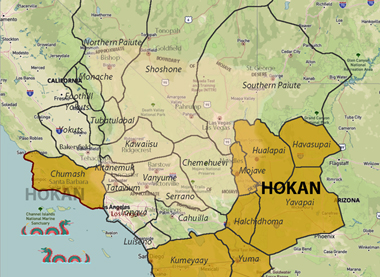Hokan Tribes
Hokan has great antiquity in California. As compared with Penutian, the inter-relationships of the Hokan languages
lie much deeper in time. The broken chain of Hokan language islands around the margins of California presumably includes the relic areas surviving from an ancient continuous distribution. Karok is one such isolate. Moratto, California Archaeology *
Mojave (Mohave)
-
Native Location: 200 mile area along the
Colorado River
from
Hoover Dam
to Blythe, and the region west of the river.
Language: Yuman
Identified Shelters: Four-posted structures built over a circular excavation, thatched with brush and covered with mud
Cultural Notes: They were once desert farmers dependent on the flood patterns of the Colorado River; they hunted, fished, and trapped.
Quechan
-
Native Location: Extends from both sides of the
Colorado River,
north of Yuma. According to tribal legend, they descended from the heights of Avikwame Mountain (Newberry Peak, near
Needles, California).
Language: Yuman
Shelter: Dome-shaped huts made of brush with an extended ramada to provide shade and food storage
Food: Salmon, bass, deer, rabbit, birds, bean pods, wheat, beans, corn, squash, and a variety of melons cultivated according to the Colorado River's flood pattern.
Washo(Washoe)
-
Native Location: Area encompassing Lake Tahoe, from Honey Lake to
Mono Lake
Language: Washo
Identified Shelters: Round or conical structures made of sixteen foot long willow or pine poles tied together in the center, covered with cedar bark, pine boughs, or manzanita; a second layer of brush and tree branches were added during the winter.
Food: Acorn, buckberry, gooseberry, sunflower seeds, currants, wild onions, rhubarb, turnips, trout, abalone, deer, rabbit, quail, grouse, mountain sheep
Chumash
-
Native Location: Area along the coast between Paso Robles and Malibu, and the Northern Channel Islands
Language: Hokan
Identified Shelters: large, circular, domed houses separating multiple family areas; a fire-pit stood in the center and a hole was left on the top of the dome for air circulation.
Food: Acorn, pine nuts, cherries, seeds, berries, deer, small game, fish, waterfowl
Kumeyaay/Kumei/Cumeyaay
(aka. Diegueño, Tipai-Ipai)-
Native Location: San Diego and Imperial Counties, to 60 miles south of the Mexican border
Language: Yuman branch of Hokan, divided by Ipai (northern dialect) and Tipai (southern dialect)
Identified Shelters: Willow frames set into the ground were curved to the center, then overlaid by brush, tulles, or tree branches.
Food: Acorn, yucca, fish, shellfish, watercress, nettle, celery, lettuce, small game
-
Atsugewi - Chimiriko - Diegueno - Halchidhoma - Ipai - Kamia - Kohuana - Salinan - Shasta - Tipai
* Moratto, Michael, California Archaeology, Academic Press, Inc., 1984
Source - State of California
